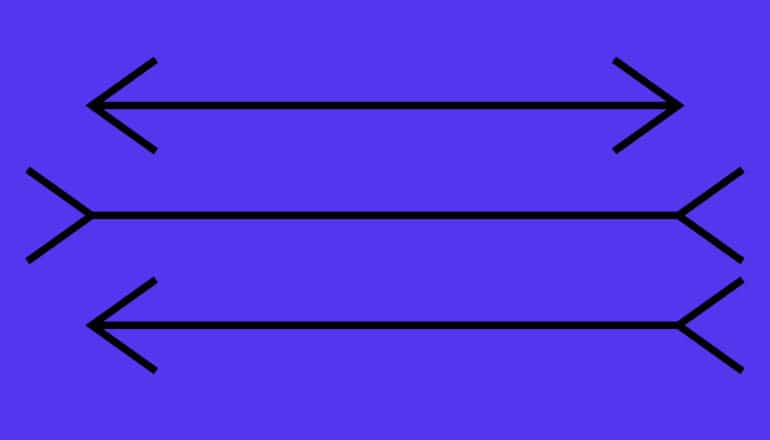
Under some circumstances, gestures can improve the accuracy of people’s descriptions of object size relative to their estimations based on sight, research on the Müller-Lyer illusion finds.
For example, imagine describing the precise dimensions of a common object, such as a coin, for another person. Do you move your hand, pretending to pick one up to show its size? If so, you likely aren’t alone.
For the study, published in Psychological Science, University of Chicago professor Susan Goldin-Meadow and her colleagues asked participants to examine and reexamine a Müller-Lyer illusion—a set of lines or sticks whose lengths appear to vary due to stylized arrow marks.
The Müller-Lyer illusion in action
The Müller-Lyer illusion is one of the most famous optical illusions in psychology. It consists of two sticks, one framed by closed fins and one framed by open fins. After seeing the illusion, viewers usually estimate that the stick with two open fins is longer, even though the sticks are actually the same length.
In the study, participants gauged the lengths of sticks placed in a frame exhibiting the illusion three times: once after looking at the sticks, once as they prepared to pick up them up, and once more while using a hand gesture to describe an action involving the sticks for another person. Their accuracy varied in a predictable way—it increased equally in both of the latter two situations, where movements were involved.
That might be because the way people perceive objects depends in part on their intentions, according to Goldin-Meadow, professor in the departments of psychology and comparative human development. If someone intends to act on an object in an optical illusion, they may gauge its length more accurately.
“When you look at the illusion, you are captured by it,” says Goldin-Meadow. “But if you begin to move as if to grab one of the objects, something different seems to happen between your hand and your mind: You’re no longer quite as susceptible to the illusion as you were. Our discovery is that your accuracy also improves when you gesture about the object while you talk, just as it does when you act.”

The ‘about this big’ gesture
Coauthors of the study are from the University of Chicago and the Max Planck Institute of Psycholinguistics in the Netherlands. Together, the researchers wanted to better understand the relationship among action, gesture, and estimation under the Müller-Lyer illusion.
The team wanted to shed light on the origin of gesture—which seems to be related to both action and speech—by evaluating the way people gauged the illusion in three contexts: estimating based on sight alone, preparing to act, and describing in speech with gesture.
The study included 45 participants, including 32 English speakers—who gestured spontaneously while speaking—and 13 users of American Sign Language (ASL), who used conventional signs to articulate their perceptions of stick length.
People were most susceptible to the Müller-Lyer illusion when they tried to estimate stick lengths without thinking about an accompanying action. For both English speakers and ASL users, however, the magnitude of the illusion lessened equally when they prepared to act or described an action for someone else.
The researchers measured the distance between the tip of the pointer finger and thumb on the right hand as people in both groups made a backwards “C” shape to gauge the length of each of four sticks of increasing length under the three different scenarios.
According to Goldin-Meadow, the fact that the illusion was less powerful when participants were describing objects with gestures suggests that the mechanisms responsible for producing gestures in speech and sign language might derive from the way we act on objects, rather than from language.
“The Müller-Lyer illusion has always fascinated me,” she says. “And using it struck me as an ideal way to ask this question about where gestures come from. I thought they were tied to language because gestures and speech are so well integrated. But now we have evidence that gestures may also stem from action.”
Source: University of Chicago
The post Hand gestures can make this illusion less tricky appeared first on Futurity.
from Futurity https://ift.tt/3zf4NTq
No comments:
Post a Comment